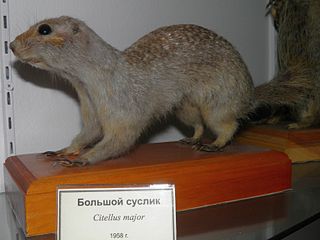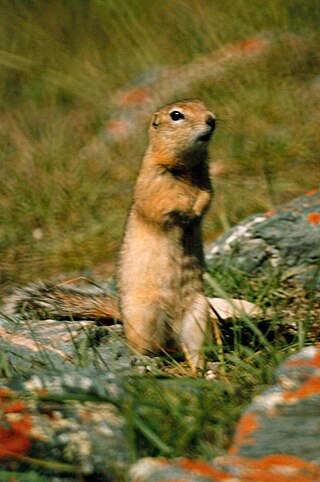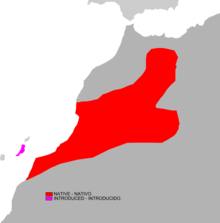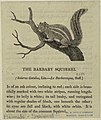
Ground squirrels are rodents of the squirrel family (Sciuridae) that generally live on the ground or in burrows, rather than in trees like the tree squirrels. The term is most often used for the medium-sized ground squirrels, as the larger ones are more commonly known as marmots or prairie dogs, while the smaller and less bushy-tailed ground squirrels tend to be known as chipmunks.

Franklin's ground squirrel is a species of squirrel native to North America, and the only member of the genus Poliocitellus. Due to the destruction of prairie, the populations of Franklin's ground squirrel have dwindled, approaching levels of concern. Its decline in the eastern portion of its range is mostly attributed to habitat fragmentation.

Xerini is a tribe of ground squirrels occurring in Africa and Asia. With the tribes Marmotini and Protoxerini, they form the subfamily Xerinae. There are five living genera—Xerus, the unstriped ground squirrel; Euxerus, the striped ground squirrel; Geosciurus, the Cape and mountain ground squirrels; Atlantoxerus, containing the living Barbary ground squirrel of North Africa and some extinct species; and Spermophilopsis, containing the long-clawed ground squirrel of Central Asia.

The European ground squirrel, also known as the European souslik, is a species from the squirrel family, Sciuridae. It is among the few European species in the genus Spermophilus. Like all squirrels, it is a member of the rodent order. It is to be found in eastern and central Europe from southern Ukraine, to Asia Minor, Austria, the Czech Republic, Slovakia, Serbia, Greece, Romania, Bulgaria, North Macedonia and north as far as Poland but the range is divided in two parts by the Carpathian Mountains.
Thomas's rope squirrel or redless tree squirrel is a species of rodent in the family Sciuridae. It is found in Benin, Cameroon, Central African Republic, Democratic Republic of the Congo, Equatorial Guinea, Gabon, and Nigeria. Its natural habitat is subtropical or tropical moist lowland forests. It is a common species and the International Union for Conservation of Nature has rated it as being of "least concern".

The tropical ground squirrel is a species of rodent in the family Sciuridae. At one time the species was originally described as Spermophilus adocetus, but the genus Spermophilus was revised and subdivided in 2009 and it was placed in the genus Notocitellus. It is endemic to arid upland areas and deciduous woodland in Mexico. It is locally referred to as Cuinique.
The ring-tailed ground squirrel is a species of rodent in the family Sciuridae. It is endemic to the Pacific coast region of central Mexico. It is a common species and feeds mainly on fruits and nuts. The IUCN has assessed it as being of "least concern".

The russet ground squirrel is a species of rodent in the family Sciuridae. It is also known as the hibernating large ground squirrel and the large-toothed souslik. It is found in west central Asia where its natural habitat is temperate grassland.
The Perote ground squirrel is a species of rodent in the family Sciuridae. It is endemic to Mexico and is currently at risk of extinction. Perote ground squirrels live within the same area as rock squirrels but they use different microhabitats. In one case it also shares its habitat with the Mexican ground squirrel. Perote ground squirrels have traits similar to those of spotted ground squirrels found in the northern Mexican Plateau; however they are larger, have shorter tails and yellow backs. Its skull is relatively narrow with a large braincase and they have heavy, thick teeth. Perote ground squirrels have two annual cycles, an active phase (March–November) and a hibernation phase (December–February). Some overlap may occur in March and November however.

The little ground squirrel or little souslik, is a species of rodent in the family Sciuridae. It is found from Eastern Europe to Central Asia.

The speckled ground squirrel or spotted souslik is a species of rodent in the family Sciuridae from Eastern Europe. Spermophilus suslicus consists of three subspecies: S. s. boristhenicus, S. s. guttatus, and S. s. suslicus. It is threatened by habitat loss.

The long-tailed ground squirrel or Eversmann's souslik is a species of rodent in the squirrel family Sciuridae. It is found in China, Kazakhstan, Mongolia, and Russia.

The rock squirrel is a species of rodent in the family Sciuridae. It is native to Mexico and the Southwestern United States, including southern Nevada, Utah, Colorado, Arizona, New Mexico, West Texas, and the panhandle of Oklahoma.

The unstriped ground squirrel is a species of rodent in the family Sciuridae. It is the only member of the genus Xerus. It is found in Djibouti, Eritrea, Ethiopia, Kenya, Somalia, Sudan, Tanzania, and Uganda. Its natural habitats are dry savanna and subtropical or tropical dry shrubland.

Whitaker's shrew is a species of mammal in the family Soricidae. It is found in Western Sahara, Algeria, Morocco, Tunisia. Its natural habitats are subtropical or tropical dry shrubland, rocky and sandy coasts. It is a fairly common species and the International Union for Conservation of Nature has rated its conservation status as being of "least concern".

The wildlife of Morocco is composed of its flora and fauna. The country has a wide range of terrains and climate types and a correspondingly large diversity of plants and animals. The coastal areas have a Mediterranean climate and vegetation while inland the Atlas Mountains is forested. Further south, the borders of the Sahara Desert are increasingly arid. Large mammals are not particularly abundant in Morocco, but rodents, bats, and other small mammals are more plentiful. Four hundred and ninety species of birds have been recorded here.

The Mediterranean woodlands and forests is an ecoregion in the coastal plains, hills, and mountains bordering the Mediterranean Sea and Atlantic Ocean in North Africa. It has a Mediterranean climate, and is in the Mediterranean forests, woodlands, and scrub biome.

The Maghreb garden dormouse is a nocturnal species of rodent in the family Gliridae. It is found in Algeria, Libya, Morocco, Tunisia and Western Sahara. Its natural habitats vary from humid forests to semi-deserts. It is a common species and the International Union for Conservation of Nature has rated it as being of "least concern".

The Mediterranean High Atlas juniper steppe is a montane grasslands and shrublands ecoregion in Morocco. It extends along the High Atlas range of northwestern Africa's Atlas Mountains.



















